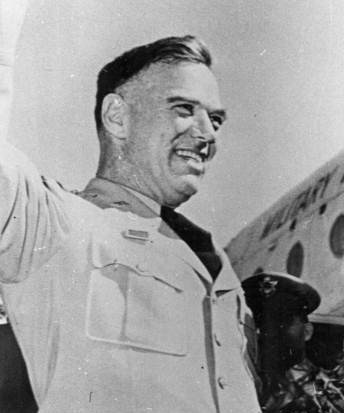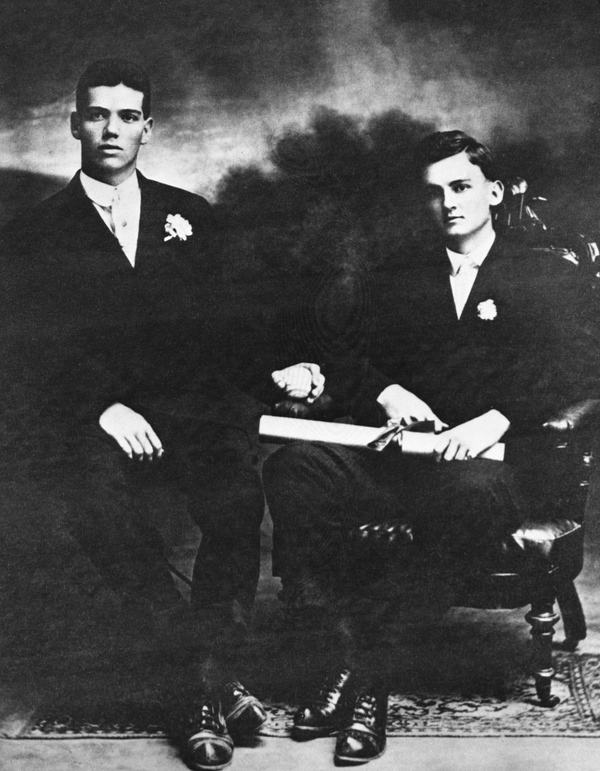Description of previous item
Description of next item
James Van Fleet and the Normandy Invasion
Published June 6, 2019 by Florida Memory
Early on June 6, 1944, a force of about 175,000 Allied troops began making their way ashore along the beaches of Normandy in Nazi-occupied France. This invasion, generally called the D-Day invasion or Operation Overlord, involved the coordinated efforts of 12 nations under the leadership of U.S. General Dwight D. Eisenhower. The goal was to establish an Allied foothold in Adolf Hitler’s so-called “Fortress Europe” and roll the Axis forces eastward while Soviet troops closed in from the opposite side. Many Floridians participated in this daunting maneuver, including a man who had grown up in Bartow in Polk County and had been a classmate of General Eisenhower–Colonel James Van Fleet.
James Alward Van Fleet was born in 1892 in Coytesville, New Jersey, but almost immediately moved with his family to Bartow, where his father invested in phosphate mining. The Van Fleet phosphate venture didn’t pan out, but James’ father, William, supported his family by running a newsstand in the Bartow post office building. In his earliest years at school, James Van Fleet was close friends with the man who would be governor of Florida during most of World War II, Spessard Holland. He later recalled the two of them being dressed by their mothers for their first day of kindergarten–both wearing suits and bowties, but barefoot. Van Fleet began attending the Summerlin Institute in 1907, although he confessed he found it difficult to concentrate on his studies. Even at a young age, he was an avid outdoorsman and worked at a local grocery and as a mail carrier, which occupied much of his time. He also played for the Summerlin football and baseball teams until a back injury kept him on the bench.
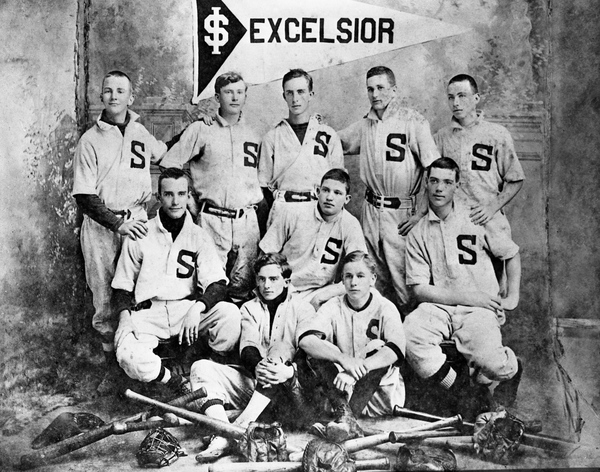
The Summerlin Institute’s 1909 baseball team. James Van Fleet is pictured in the middle row on the far right.
In 1911, Van Fleet received a congressional appointment from U.S. Representative Stephen M. Sparkman to the United States Military Academy at West Point. His cohort, the Class of 1915, was later nicknamed the “class the stars fell on” because so many of the members became generals. Both Dwight Eisenhower and Omar Bradley were among them.
After graduating 25th in his class at West Point with the rank of Second Lieutenant, Van Fleet chose to become an infantry officer. “Infantry is the heart of the United States Army,” he later said. “Armor and artillery are powerful allies, but it is the infantry that seizes territory and holds it.” His first assignment was with the 3rd Infantry Regiment in New York, where he helped train civilian volunteers for potential service in the event of U.S. involvement in World War I. In 1916, the 3rd Infantry moved to Camp Eagle Pass on the U.S.-Mexican border to help contain unstable conditions stemming from the Mexican Revolution. Van Fleet also served as an instructor at Fort Leavenworth, Kansas, and overseas with the 6th Division during World War I.
After the war, Van Fleet became an ROTC instructor at Kansas State Agricultural College, the first of several ROTC posts he would hold in the interwar era. In 1921, he was transferred to the University of Florida, where he commanded the ROTC cadets and served as head coach of the football team. He almost left the Army to accept a lengthy contract as head coach, but he eventually decided to stay in the military. Over the next few years, he served in a variety of roles–commanding troops in Panama, coaching the Army’s football team, serving another stint at the University of Florida, and supervising several camps of the Civilian Conservation Corps during the Great Depression.
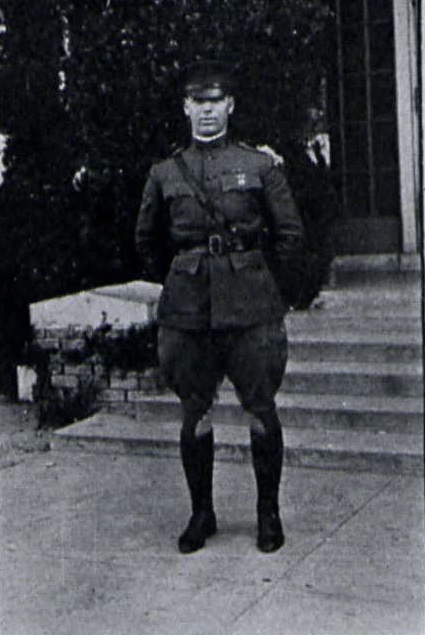
James Van Fleet as commander of the ROTC cadets at the University of Florida. Taken from UF’s yearbook, The Seminole (1922).
Van Fleet was in the process of transferring to Fort Benning, Georgia, for duty when Hitler’s army invaded Poland in 1939. After two years training the troops at Benning, he was elevated to the rank of colonel and given command of the 8th Infantry, 4th Division. When the 4th was retooled as a motorized division–designed to handle tanks, trucks, half-tracks and the like–he led his regiment through a lengthy series of maneuvers to train for combat. Colonel Van Fleet’s men were passed up for participation in the Allied invasion of North Africa, as was the entire 4th Division, but they didn’t have to wait much longer to join the fighting. In late fall 1943, the 4th was ordered to prepare to ship overseas. Their destination would be the heavily fortified western coast of Europe.
Although the plans for the invasion of Europe were under tight wraps, Van Fleet and his men had some idea of what to expect because of their extensive training. Some of that training took place in Florida at Camp Gordon Johnston, located in the Panhandle near Carrabelle. Here the soldiers practiced the best ways to launch an amphibious invasion, including the use of new amphibious vehicles like the DUKW (commonly called a “duck”) and LCVP (commonly called a “Higgins boat”). By the end of December 1943, the 4th Division had finished up its Florida training and was en route to England to prepare for D-Day.
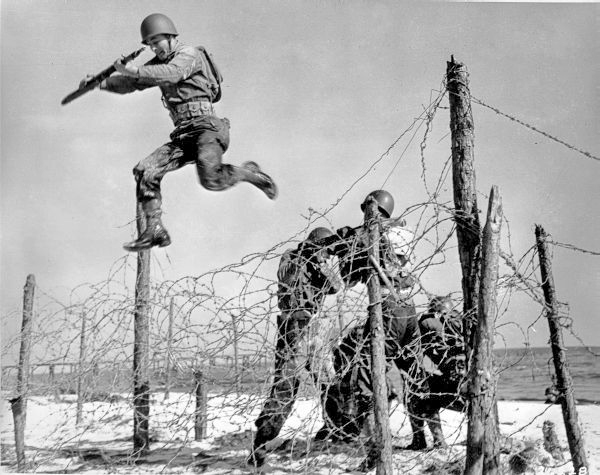
Soldiers training for amphibious warfare at Camp Gordon Johnston near Carrabelle, Florida (ca. 1943).
Operation Overlord, as the invasion was code-named, called for five main invasion zones–Utah, Omaha, Gold, Juno and Sword. United States forces concentrated on Utah and Omaha beaches. Colonel Van Fleet’s regiment was assigned to Utah Beach and scheduled to land at 6:30 a.m. local time, the H-Hour of D-Day. As the transport ships chugged across the churning waves of the English Channel, soldiers battled seasickness and feverish anticipation for the fight to come. As daylight began to break, Allied gunboats unleashed punishing artillery fire on the German beach defenses, providing cover for the invading troops. The initial deployment of men and equipment didn’t go off without a hitch–a few of the ships hit mines, some drifted away from their targets in the swift currents and many of the smaller boats stopped well short of the shoreline, forcing the troops to wade ashore just as the Germans were beginning to return fire. Colonel Van Fleet’s 8th Regiment ended up landing south of its assigned beachhead but were determined to make the most of their situation. By mid-morning, they had neutralized several German pillboxes (small concrete forts) and threaded their way through minefields, opening up an exit from the beach for the troops that would follow them.
For his leadership of the 8th Regiment during the Normandy invasion, Colonel Van Fleet was awarded the Distinguished Service Cross. He was also promoted to Brigadier General on August 1, 1944, and reassigned to assist in commanding the 2nd Division. In less than a year, he replaced General John Millikin as commander of the 3rd Corps in General George S. Patton’s 3rd Army.
General Van Fleet continued to lead a distinguished military career after World War II. He served in Greece and Korea, commanding the 2nd and later the 8th armies as the United States fought on multiple fronts to contain the spread of Communism during the Cold War. He retired from active duty in 1953, arriving home in Florida to a triumphant welcome.

General James Van Fleet (right) with Loyal Frisbie (left), chairman of Polk County’s “Welcome Home” celebration in honor of the general’s return to Florida (1953).
General Van Fleet turned down several opportunities to run for public office, but did write and make public appearances in support of various causes. He also operated a ranch and citrus groves near his home in Polk County. He passed away peacefully on September 23, 1992, six months after celebrating his 100th birthday.
For more information on the life and military career of General James A. Van Fleet, we recommend Paul F. Braim, The Will to Win: The Life of General James A. Van Fleet (Annapolis: Naval Institute Press, 2001).
Cite This Article
Chicago Manual of Style
(17th Edition)Florida Memory. "James Van Fleet and the Normandy Invasion." Floridiana, 2019. https://www.floridamemory.com/items/show/342059.
MLA
(9th Edition)Florida Memory. "James Van Fleet and the Normandy Invasion." Floridiana, 2019, https://www.floridamemory.com/items/show/342059. Accessed January 1, 2026.
APA
(7th Edition)Florida Memory. (2019, June 6). James Van Fleet and the Normandy Invasion. Floridiana. Retrieved from https://www.floridamemory.com/items/show/342059

 Listen: The Blues Program
Listen: The Blues Program